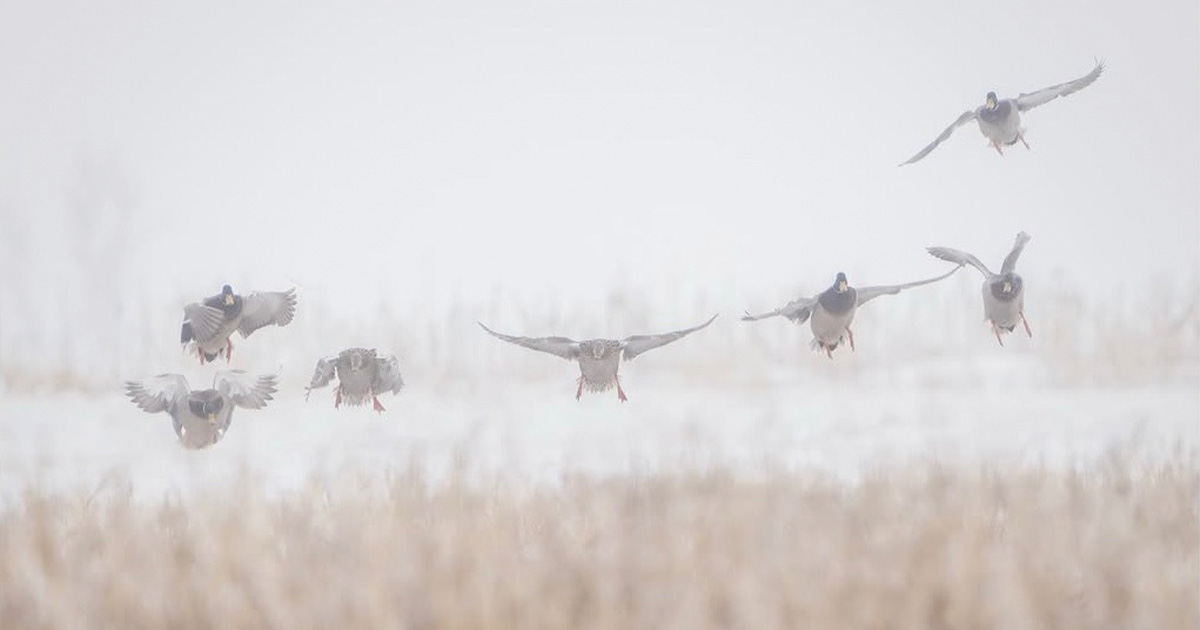Migration Alert: Migration Throughout the Great Lakes Region Increases Following Winter Weather
Nov. 14, 2025 – Great Lakes Region
Nov. 14, 2025 – Great Lakes Region

Last weekend, winter weather slammed much of the Great Lakes Region as a series of significant weather systems impacted much of country, prompting a classic November migration event many hunters have not seen in several seasons. Strong duck, goose, swan, and crane flights began late last week and kicked into hyperdrive this past weekend.
After weeks of stale ducks, hunters were elated to have a crack at workable birds, and reports from around the region have been outstanding. Mallards finally appeared where they had been scarce, while hordes of divers such as redheads, bluebills, and canvasbacks were also moving through the southern half of the Great Lakes states.
“We did see a significant migration into Wisconsin Saturday, Sunday, and Monday with the snow and cold conditions,” says Taylor Finger, Wisconsin Department of Natural Resources (WDNR) migratory game bird biologist. “Based on reports, good numbers of divers moved into the state on the east and west side, while excellent numbers of dabblers moved in across the entire state.”
To the south, Illinois’s waterfowl superhighways were also running at full capacity. “Sunday, we saw a trickle of birds coming in to start, and it increased as the day progressed,” says Austin Matheny, who hunts the Illinois River Valley almost daily. “Monday, new ducks had arrived, but we had mixed results. Tuesday and Wednesday were much better.”
Matheny reports canvasbacks began showing up, along with other divers, green-winged teal, mallards, and a variety of other dabblers.
Heavy snow and gale force winds hammered northwest Indiana and southwest Michigan starting Sunday, and by all accounts, hunting was outstanding through early this week. Reports of exceptional numbers of ducks were the norm on inland lakes and large marshes, while small waters began to freeze. While some waterfowl appear to have moved southward, good numbers of ducks and geese are still present in fluctuating numbers.
“Dropping temperatures, north winds, and snow squalls last weekend were a welcome sight for weary duck hunters around Saginaw Bay. Sunday and Monday were both iconic type waterfowl hunting days as temps hovered in the 20s,” explains Michigan Department of Natural Resources (MDNR) Biologist Ryan Soulard. “Ice made its first appearance in protected areas and shallow spots but has since dwindled with above freezing temperatures.”
Soulard also reports redhead numbers have improved on Saginaw Bay, while bluebills remain. “Tundra swans have been pouring into the region over the last four days, along with some early arriving goldeneyes, as well as mallards, black ducks, and pintails.”
To the south, hunters and guides report much improved duck numbers and hunting on Lake St. Clair and the western basin of Lake Erie, including on Ohio’s world class marshes.
Near summer temperatures are predicted this coming weekend, likely slamming the brakes on any significant migration. However, winterlike conditions are forecasted to return at the end of the month. In the meantime, days are short and the sun remains low in the sky. Some waterfowl zones are on the verge of closing, while others are just opening in the south. The bottom line is, with the influx of “new” waterfowl, there’s no time better than the present to get out and enjoy the migration.
Stay up to date with the latest migration information.
Ducks Unlimited uses cookies to enhance your browsing experience, optimize site functionality, analyze traffic, and deliver personalized advertising through third parties. By continuing to use this site, you agree to our use of cookies. View Privacy Policy